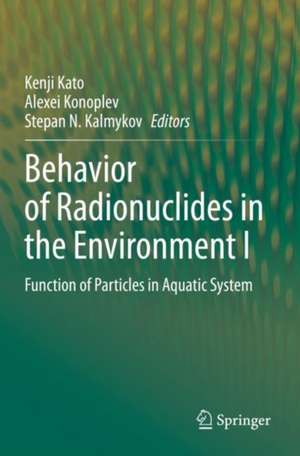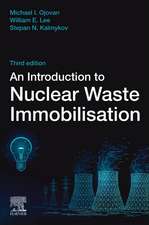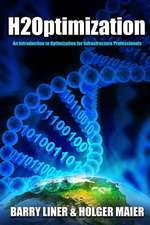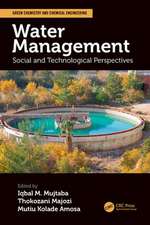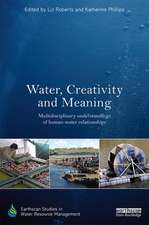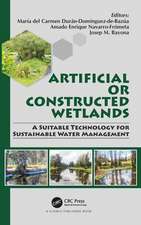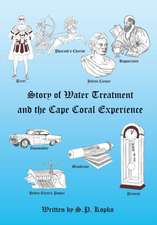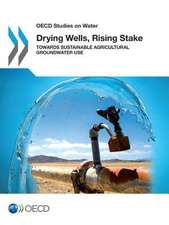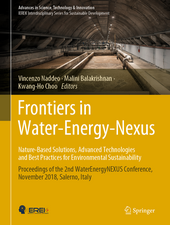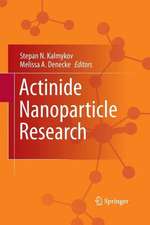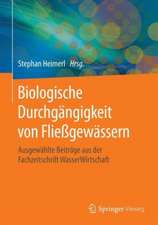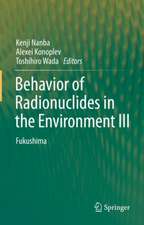Behavior of Radionuclides in the Environment I: Function of Particles in Aquatic System
Editat de Kenji Kato, Alexei Konoplev, Stepan N. Kalmykoven Limba Engleză Paperback – 26 aug 2021
Volume I presents the experiences gained in South Urals (“Mayak” plant, Lake Karachai), providing a scientific basis for more precise understanding of the behavior of radionuclides in complex subsurface environments. On the basis of monitoring data, it examines the pathways of radionuclide migration and the influence of the geological environment and groundwater on the migration, with a particular focus on particles from the nanoscale to microscale. It also discusses the function of microbes and microscale particles, from their direct interaction with radionuclides to their ecological role in changing the physic-chemical condition of a given environment. Lastly, the protective properties of geological media are also characterized, and mathematical modeling of contaminant migration in the area of Lake Karachai is used to provide information regarding the migration of radionuclides.
| Toate formatele și edițiile | Preț | Express |
|---|---|---|
| Paperback (1) | 728.78 lei 39-44 zile | |
| Springer Nature Singapore – 26 aug 2021 | 728.78 lei 39-44 zile | |
| Hardback (1) | 891.33 lei 3-5 săpt. | |
| Springer Nature Singapore – 19 feb 2020 | 891.33 lei 3-5 săpt. |
Preț: 728.78 lei
Preț vechi: 958.92 lei
-24% Nou
Puncte Express: 1093
Preț estimativ în valută:
139.46€ • 149.12$ • 116.27£
139.46€ • 149.12$ • 116.27£
Carte tipărită la comandă
Livrare economică 14-19 aprilie
Preluare comenzi: 021 569.72.76
Specificații
ISBN-13: 9789811506819
ISBN-10: 9811506817
Pagini: 225
Ilustrații: X, 225 p. 93 illus., 63 illus. in color.
Dimensiuni: 155 x 235 mm
Ediția:1st ed. 2020
Editura: Springer Nature Singapore
Colecția Springer
Locul publicării:Singapore, Singapore
ISBN-10: 9811506817
Pagini: 225
Ilustrații: X, 225 p. 93 illus., 63 illus. in color.
Dimensiuni: 155 x 235 mm
Ediția:1st ed. 2020
Editura: Springer Nature Singapore
Colecția Springer
Locul publicării:Singapore, Singapore
Cuprins
1 Microbial ecological function in migration of radionuclides in groundwater.- 2 Microbial diversity and possible activity in nitrate- and radionuclide-contaminated groundwater.- 3 Function of microbes on chemical species transformation of radionuclides.- 4 Direct detection of denitrifying bacteria in groundwater by GeneFISH.- 5 Difference in the solid-water distributions of radiocesium in rivers in Fukushima and Chernobyl.- 6 Function of colloidal and nanoparticles in sorption of radionuclides.- 7 Application of electron microscopy to understanding colloid-facilitated transport of radionuclides at the Mayak Production Association facility, near Lake Karachai, Russia.- 8 Numerical analysis of migration of nitrate ions in the groundwater system of Lake Karachai Area, Southern Ural, Russia.- 9 Commentary on the function of micro- to nano-scale particles in radionuclide migration through groundwater.
Notă biografică
Kenji Kato
Shizuoka University
Faculty of Science
Shizuoka, JapanAlexei Konoplev
Fukushima University
Institute of Environmental Radioactivity
Fukushima, Japan
Stepan N. Kalmykov
Lomonosov Moscow State University
Radiochemistry Division
Moscow, Russia
Shizuoka University
Faculty of Science
Shizuoka, JapanAlexei Konoplev
Fukushima University
Institute of Environmental Radioactivity
Fukushima, Japan
Stepan N. Kalmykov
Lomonosov Moscow State University
Radiochemistry Division
Moscow, Russia
Textul de pe ultima copertă
The 3-volume set highlights the behavior of radionuclides in the environment and focusing on the development of related fields of study, including microbiology and nanoscience. In this context, it discusses the behavior of radionuclides released in areas of Lake Karachai in Ural, and those released as a result of Chernobyl accident (1986), and in Fukushima (2011).
Volume I presents the experiences gained in South Urals (“Mayak” plant, Lake Karachai), providing a scientific basis for more precise understanding of the behavior of radionuclides in complex subsurface environments. On the basis of monitoring data, it examines the pathways of radionuclide migration and the influence of the geological environment and groundwater on the migration, with a particular focus on particles from the nanoscale to microscale. It also discusses the function of microbes and microscale particles, from their direct interaction with radionuclides to their ecological role in changing the physic-chemical condition of a given environment. Lastly, the protective properties of geological media are also characterized, and mathematical modeling of contaminant migration in the area of Lake Karachai is used to provide information regarding the migration of radionuclides.
Volume I presents the experiences gained in South Urals (“Mayak” plant, Lake Karachai), providing a scientific basis for more precise understanding of the behavior of radionuclides in complex subsurface environments. On the basis of monitoring data, it examines the pathways of radionuclide migration and the influence of the geological environment and groundwater on the migration, with a particular focus on particles from the nanoscale to microscale. It also discusses the function of microbes and microscale particles, from their direct interaction with radionuclides to their ecological role in changing the physic-chemical condition of a given environment. Lastly, the protective properties of geological media are also characterized, and mathematical modeling of contaminant migration in the area of Lake Karachai is used to provide information regarding the migration of radionuclides.
Caracteristici
Allows readers to gain a detailed understanding of the function of particles in the migration of radionuclides in groundwater from the study in southern Ural Presents a microbial study offering fresh insights into the movement of radionuclides in aquatic systems Includes original and review articles suggesting the necessity of multidisciplinary, synthesized studies
